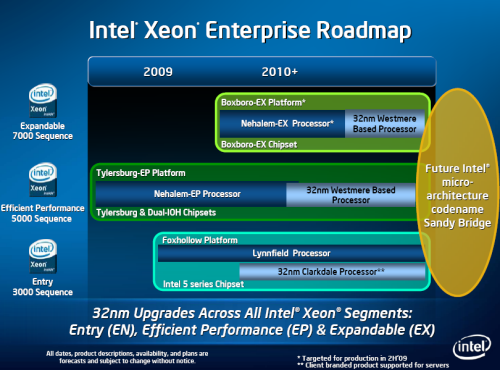How does it play out?
Break it down
Looking at it with a little greater granularity, the supporting chipset, the also-new 5-series, will enable a two-chip solution, with the bulk of the processing done on the processor side. As a mid-range system, then, Clarkdale's PCIe graphics will hang off the processor and not the supporting chipset, and will feature 16-lane traffic, broken into either a single x16 slot or two x8 for, presumably, multi-GPU usage, although Intel wouldn't confirm (or deny) whether SLI or CrossFireX would be supported. Our bet is on both.
Bear in mind that both 45nm Lynnfield and 32nm Clarkdale will be supported for at least a year, on the same socket.
Mobile decisions
Back to the roadmap, Centrino 3 (Calpella) will debut on 45nm Clarksfield on the high-end, encompassing quad-core Nehalem, but also support dual-core-plus-integrated-graphics Arrandale, this time based on Westmere. The options, therefore, are high-end CPU performance with a discrete graphics card, or an all-in-one, low-cost laptop on 32nm. Previous 45nm dual-core Nehalem chips known as Havendale and Auburndale have been given the boot with the pulling in of 32nm, though.

Enterprise customers can look forward to 32nm goodness in a bottom-to-top manner. The low-end 3000-series and mid-range 5000-series will receive socket-compatible Westmere-based Xeons before the high-end does, although the eight-core Nehalem EX should keep things ticking over until then.
Summary
Intel has brought in the time-to-market of its 32nm Westmere architecture, thereby removing a number of Nehalem-based parts from the 2009/2010 roadmap. Ostensibly Nehalem in design, Westmere's reduced size means that Intel can bring integrated graphics right on to the same package as the CPU on select mid-to-low-end parts.
We'll see the first substantiations of Westmere on the desktop and mobile platforms in late 2009 or early 2010 - and all the chips in this space, it seems, will feature integrated graphics, whether you like it or not. Product branding may become confusing between Nehalem- and Westmere-derived parts on the same socket - 5-series chipset - and we may well see Core i5 (Nehalem) and Core i5G (Westmere) come into being.
The high-end Nehalem Core i7 will remain the champ for 2009, to be replaced by a six-core monster in 2010. Intel isn't divulging clock-speeds, cache counts, or IPC improvements just yet, but expect high-end Westmere to be a few per cent faster, and significantly so in multi-threaded apps.
We're eager to see how the IGP version of Westmere performs, because it paves the way for cheaper mid-range notebooks with consummate processing power - on the CPU at least.













